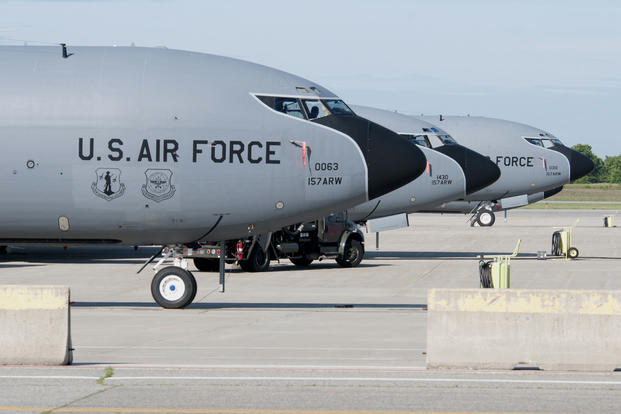The head of U.S. Transportation Command (TRANSCOM) called Tuesday for the U.S. Air Force to slow the retirement of more than 20 aerial refueling tankers slated to be cut in its fiscal 2021 budget request, saying doing so is necessary to reduce stress on overtasked aircrews.
Army Gen. Stephen Lyons told the Senate Armed Services Committee during a hearing Tuesday that the Air Force should keep some of the tankers slated for the boneyard in order to avoid mission gaps while it works with Boeing Co. to fix its newest tanker, the KC-46 Pegasus, and trains aircrews working on legacy tankers to convert to the new aircraft.
Lyons said that 13 KC-135 Stratotankers and 10 KC-10 Extenders "must be retained" out of the 29 tankers that the Air Force plans to cut. The request is the command's leading unfunded priority, which he proposed in a Feb. 20 letter sent to Capitol Hill, Breaking Defense reported.
"In some scenarios, we're tail limited; in some scenarios, we're crew limited," Lyons said during the hearing. He stressed that the deploy-to-dwell ratio is running higher for some airmen, especially those serving in the Air National Guard.
Related: The Air Force Wants to Retire Aging Aircraft. It Will Have to Get Past Congress First
"Particularly in the Guard, I would say we do come very, very close, [or we] penetrate the mode to dwell in that particular force element," he said.
Lyons' request comes as the Air Force's budget calls for retiring 16 KC-10s and 13 KC-135s from its total force inventory.
This is not the first time military officials have suggested a halt in aircraft retirements, especially in the tanker community.
Last month, Lyons said the Pentagon should explore an air refueling leasing program with the defense or commercial industry because of the KC-46's problems, which have included how its boom connects and disconnects from other aircraft; foreign object debris, such as trash, tools, nuts and bolts, found scattered inside multiple planes; and a glitch in its Remote Vision System (RVS) software, among others.
The first KC-46s were delivered in January 2019 despite the RVS problem, a critical capability that permits the in-flight operator to view the refueling system below the tanker.
"We are taking a look at [leasing]," Lyons said during an event hosted by the Atlantic Council in Washington, D.C., on Jan. 28.
An immediate, positive effect of leasing would be relieving the stress put on refueling operators and pilots, he said. "We wouldn't be able to employ that capability in a contested environment, but nonetheless ... much like we do on airlift, it would be able to take the pressure off."
The effort could also include tanker leasing opportunities for the commercial airlift industry already working with TRANSCOM.
In September, Gen. Maryanne Miller, head of Air Mobility Command, confirmed the KC-46 isn't likely to deploy to a combat zone for at least three years, given its setbacks.
As a result, AMC has also been weighing how to potentially slow the retirement of older KC-10s and KC-135s, she said at the time.
-- Oriana Pawlyk can be reached at oriana.pawlyk@military.com. Follow her on Twitter at @Oriana0214.
Read more: Duckworth: Army's New Helicopters Should Not Be Designed for Anyone Else













